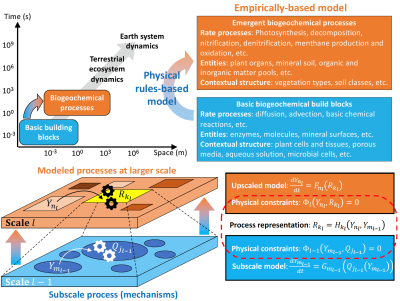A New Paradigm for Improving Ecosystem Biogeochemistry Models
Robust and accurate ecosystem biogeochemical models are required to develop effective climate mitigation strategies. However, existing biogeochemical models are very uncertain due to (1) inaccurate initial and boundary conditions, (2) uncertain model parameters, (3) insufficient model structures and processes, and (4) inaccurate numerical implementations. In this paper, we identify the fundamental insufficiency of empirically-based process parameterizations as a critical factor contributing to these four issues. We propose that physical rules-based approaches can help formulate more accurate and robust ecosystem biogeochemical models, and improve model-experiment integration and ecosystem biogeochemistry analyses.
Our new paradigm (1) explains why existing ecosystem biogeochemical models are limited even if new processes are included and more observations are used to constrain model parameters; (2) shows that physical rules can improve the scaling coherence between interacting processes, (3) helps develop more robust ecosystem biogeochemical models that are less sensitive to parameters, and (4) provides better integration between ecosystem biogeochemical models and empirical measurements.
Accurately predicting how terrestrial ecosystems will respond to climate change can help design more effective mitigation measures. However, current ecosystem biogeochemical models are unable to meet this challenge due to their large prediction uncertainty. We explain that the wide use of empirically-based parameterizations of ecosystem biogeochemical processes and the associated multiplicative constraint and law of the minimum approaches limit improvement of existing ecosystem biogeochemical models. Instead, we show that integration of physical rules in ecosystem biogeochemical models can enhance scaling coherence between interacting biogeochemical processes, thereby reducing parametric sensitivity and improving predictive robustness. As physical rules explicitly relate the many interacting processes, the resultant model will provide more specific model parameters to measure and help closer integration between model and empirical experiments. We contend that a generation of physical rules-based ecosystem biogeochemical models can be developed by adopting this new paradigm, bringing together experts from various disciplines and adopting interdisciplinary training of graduate students and postdoctoral scientists.

